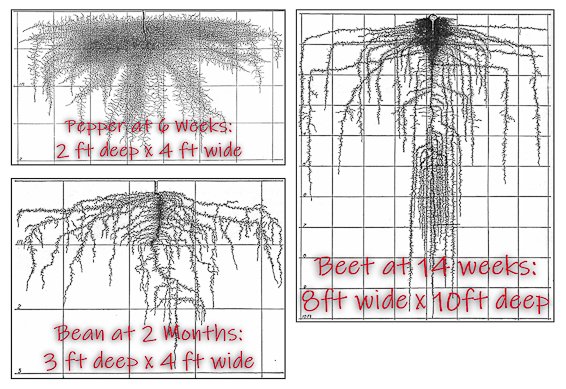| Back to Back Issues Page |
 |
|
Under the Arbor Issue 37 March 27, 2023 |
In This Issue:~ 10 Tips for Healthy Roots ~The Foundation of a Healthy Garden and Nutritious Food
Above: Three of John Weaver's Root Drawings
Sometimes life has a way of overriding our little plans. Like a root running into a big rock, a plan might be forced to take a detour before proceeding. My better-late-than-never plan this month is to expose the inner workings of roots, which don't get much glam in bloggerville. But those gorgeous flowers and voluptuous tomatoes that always seem to steal the limelight have something in common: the miracle of the unseen rhizosphere, the underground ecosystem where roots, bacteria, fungi and other backstage - er, underground - players make the show go on. Most gardeners don't think much about what goes on below ground. But in 1927 University of Nebraska researcher John Weaver decided to dig down - way down, far and wide - to find out. What he discovered - and painstakingly documented - was absolutely astonishing. Roots go far deeper and wider than anyone ever imagined. And in the last decade, even more astonishing discoveries have been made about the incredibly complex, active relationships that plant roots have with soil microbes, where intentional cooperation benefits "everyone". "Active" and "intentional"? Yup. The plant is in symbiotic relationships with at least three types of microbes with which they communicate via chemical messages. The first microbes that roots talk to and barter with are known as arbuscular mycorrhizal fungi ("AMF"), which function as root extenders. One end of the fungal filament enters the root between cells, and the other end extends up to 18" out into the surrounding soil - where they may connect to other filaments and form vast networks. The plant exudes chemicals that tell the AMF exactly what mineral nutrient(s) it needs, which the fungi then gather and transport back to the plant root. The plant "pays" for the minerals with sugars it has made through photosynthesis. This isn't just some random chemical-diffusion thing… it's specific and intentional. Then there are soil bacteria, which also trade minerals for food, but in a different way. These guys cluster around the root cap near the tip, which provides the plant some protection from predators and viral disease. But there are some bacteria that plant roots actually "eat", engulfing the bacteria and bringing them inside the root. Once the bacteria are inside, the plant "chews off" the bacteria's cell wall and a small amount of its payload, but doesn't kill it. Here inside the root, protected from soil predators themselves and fed root exudates, the bacteria multiply like crazy. The expanding bacterial population pushes out, forming new root hairs! Eventually the root spits the partially-digested bacteria back out into the soil, where they grow new protective cell walls, accumulate more nutrients and do the whole cycle again. Ten Tips for Healthy Roots
DedicationVegetable Garden Guru is dedicated to the renewal of regenerative, sustainable, organic vegetable gardening around the world. May we become gardeners of healthful, nutrient-dense food, careful stewards of soil, and may the plants we tend remind us to always keep growing toward the Light.
|
| Back to Back Issues Page |

